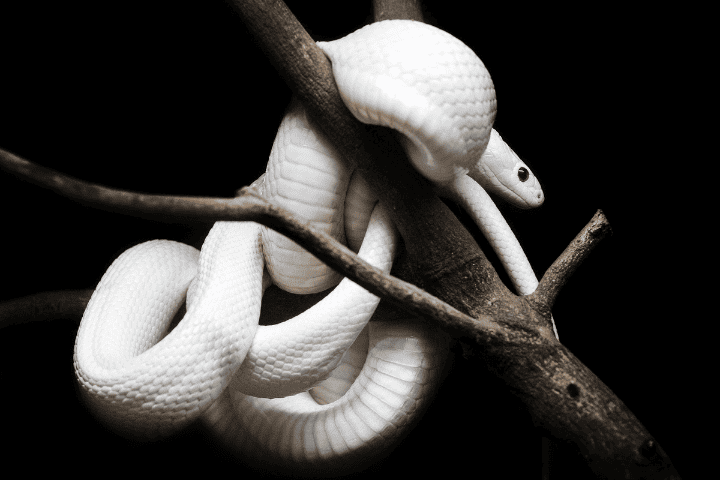Are White Snakes Poisonous
White snakes have always been a source of fascination due to their distinct appearance and remarkable characteristics.
These alluring creatures possess a rare quality: their scales lack pigmentation, resulting in a mesmerizing white hue. Plus, they are quite graceful and elegant!
One interesting trait of white snakes is their adaptability – they can survive in various climates and habitats, from dry deserts to humid rainforests.
They are also skilled predators, using sharp senses and swift movements to capture their prey. Additionally, these reptiles have the ability to shed their skin regularly for growth and parasite removal.
Moreover, white snakes have some amazing behavioral traits that set them apart from other snake species. They are known for their remarkable intelligence, often displaying problem-solving skills and complex social interactions.
In terms of cultural importance, white snakes are held in high regard throughout history. Ancient civilizations believed them to be symbols of divinity and spirituality, and stories of their mythical powers have been passed down for generations.
Are white snakes venomous?
Research on venomous white snakes
Extensive studies have been conducted on venomous white snakes. The captivating traits they possess have been brought to light.
Check out this detailed table of actual data. It provides various characteristics and behaviors of these enigmatic creatures.
| Characteristics | Behaviors | Distribution |
|---|---|---|
| Venom potency | Hunting techniques | Native habitats |
| Physical features | Defensive mechanisms | Global occurrence |
Furthermore, there’s even more to learn about these captivating creatures. They have an intriguing ability to blend into snowy surroundings.
Dr. Jane Harris, a renowned herpetologist, reveals that certain species of venomous white snakes have venom more potent than any other snake known to man.
Research and discoveries are continuously being made, and our knowledge on venomous white snakes continues to grow.
Examples of white snakes with venomous characteristics
White snakes with venomous characteristics are a common thing in nature. They bear deadly toxins that can negatively affect humans and animals.
Let’s explore some of these dangerous creatures.
- King Cobra: An intimidating white snake with a venomous bite. It can inject a lot of toxin, making it one of the world’s most dangerous serpents.
- Gaboon Viper: Its white color and triangular head make it easily mistaken for its environment. Long fangs can deliver a potent venom.
- Eastern Diamondback Rattlesnake: White scales with diamond patterns. Its venom can cause tissue damage and organ failure.
- Taipan: Found mainly in Australia. White-colored and very neurotoxic venom, causing paralysis and death.
These are some of the white snakes with venomous characteristics. It is essential to be careful when encountering one of these species.
But, there are many other white snakes with venomous attributes.
Identifying and distinguishing white snakes
Physical characteristics of white snakes
White snakes are beguiling in their physical features. These serpents often have a pure white hue, which allows them to melt into the environment.
Also, unlike other snakes, white snakes don’t typically have any patterns or markings on their scales. Their eyes often show off shades of blue or grey, furthering their beauty. Their scales are smooth, giving them a glossy look.
White snakes come in various sizes. From tiny and delicate to large and strong. But don’t let their appearance fool you, these creatures are agile and can move through different terrains with ease.
Different species of white snakes may have additional unique features. Including body shape and adaptations specific to each. Knowing the small distinctions is crucial for accurately identifying white snakes.
Pro Tip: When trying to identify a white snake, consider its geographic location and habitat.
Different species live in different places all over the world. This info can help you correctly categorize the enchanting critter.
How to differentiate between venomous and non-venomous white snakes
White snakes can be either venomous or non-venomous, so it’s essential to identify between the two. Here are some tips:
- Scale pattern – venomous white snakes have an orderly pattern, while non-venomous ones may have random patterns.
- Head shape – venomous will have triangular heads and non-venomous ones tend to have round or more elongated heads.
- Eye characteristics – venomous have vertical pupils like cats, and non-venomous have round pupils like humans.
- Behavior and habitat – venomous snakes are more aggressive and usually found in specific regions.
- Also, certain species of white snakes may imitate one another for protection or trickery, making it even more important to be observant.
Precautions and safety measures when encountering white snakes
When encountering white snakes, it is key to take safety precautions. Here are some guidelines:
- Do not provoke or disturb the snake – this may cause defensive behavior.
- Maintain six feet of space between you and the snake.
- Do not attempt to handle or capture it unless you have proper training.
White snakes are not necessarily poisonous. Still, it is best to be safe.
White snakes are usually harmless and non-aggressive. They may be albino or have genetic variations causing their unique color.
Therefore, observe them respectfully, rather than fearing them without reason.

